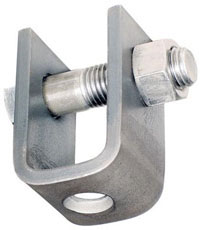
What is a Turnbuckle?
A turnbuckle, also known as a stretching screw or bottle screw, is defined as “a device for adjusting the tension or length of ropes, cables, tie rods and other tensioning systems.” Although this piece of hardware has very compact dimensions, but with larger dimensions, it can be used for equipment setups and can withstand huge weights.
Since its invention in the 1950s, the design of the turnbuckle has not changed much. But many different types, designs and sizes have been added offered by industrial hardware suppliers - so it is important to understand this information when buying turnbuckles.
Parts of the turnbuckle
The turnbuckle consists of three main parts: the body, the clamping nut and the end fitting. These parts may be made of different designs or materials, so it is important to know the name and purpose of each part.
The body is the metal frame in the center of the turnbuckle. This is the part that rotates so that the end pieces slide out or in on either side. This is what creates the tension.
The body of a turnbuckle can be open or closed. A turnbuckle with an open body exposes the threads of the end fittings, making it easier to see how far the turnbuckle has extended. A turnbuckle with a closed body encloses the threads. This provides slightly more support and a smaller frame that is ideal for smaller fits.
The jam nut is a traditional nut used to screw the end fittings into the housing. The jam nut can be tightened to hold the end fittings more firmly in place in the housing.
The end fittings are on either side of the turnbuckle. These serve as connection points for e.g. hoisting equipment. There are different styles of end fittings that can be used, depending on the application. These parts can also be combined - the two end fittings do not necessarily have to match.
Types of Turnbuckles
There are several types of turnbuckles. The main difference is the combination of the end fittings. As mentioned earlier, the end fittings do not necessarily have to match.
The typical styles of end fittings offered by most industrial hardware suppliers are..
- Hook and Hook Turnbuckles: Two Hooks at each end
- Eye and Hook Turnbuckles: One Loop and one open Hook
- Eye and Eye Turnbuckles: Two rounded Loops at each end
- Jaw and Jaw Turnbuckles: Two U-shaped openings with pin and screw closure
- Eye and Jaw Turnbuckles: One closed Loop and one U-shaped opening with pin and screw closure





These different fittings are used to connect different types of industrial hardware together for various applications. For example, an end fitting with an eye can be used to connect a loop to an industrial wire rope or cable. A hook would be optimal for an application that needs easy release, while an end fitting with a jaw creates a more secure, permanent connection.
Turnbuckles can also be made of different materials, depending on the application. Stainless steel turnbuckles are the most robust, as this metal is naturally corrosion resistant. Stainless steel turnbuckles are recommended for applications exposed to the elements, such as ship rigging. Most industrial hardware suppliers also offer turnbuckles with a forged, hot-dip galvanized finish for added protection.
Where are turnbuckles used?
Turnbuckles are used for many types of applications in many industries, including..
- Piping systems
- Maritime transport
- Bridge Construction
- Aircraft construction
- Ship rigging and lashing
- Overhead hoisting and lifting
The primary purpose of the turnbuckle is to easily adjust tension within a rig. This can be used for simple setups such as fences or boxing rings, as well as large projects such as suspension bridges and aircraft.
The most important element of a turnbuckle is the quality of its material and construction. Since this small piece of hardware is responsible for securing heavy loads, it must also withstand tension and weight without warping or loosening. The material must be durable to withstand external factors such as moisture, direct sunlight, temperature changes and changes in weight loading.
It is important to note that turnbuckles should be inspected before use and wear or damage should be replaced. If any parts appear corroded, rusted or damaged, the turnbuckle should not be used.
Related Post(s)

On this page are the most common standard pipe supports specified, but there are many more standards available. MSS SP-58 for instance has more then 60 standard Support types...

